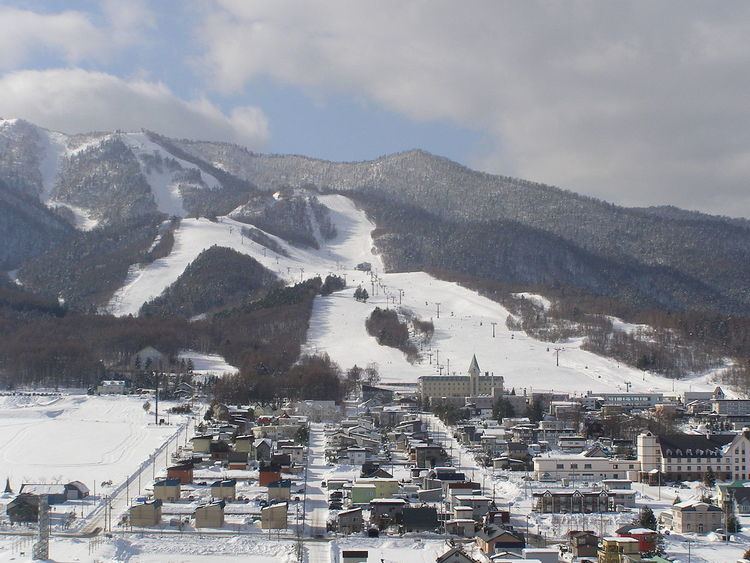Region Hokkaido | ||
 | ||
Time zone Japan Standard Time (UTC+9) Website www.city.furano.hokkaido.jp | ||
Furano (富良野市, Furano-shi) is a city in the prefecture of Hokkaido, Japan, located in the southern reaches of Kamikawa Subprefecture, under whose jurisdiction it resides. Well known throughout Japan as a tourism destination, it is famous for its lavender fields, the television drama Kita no Kuni kara and the Furano Ski Resort, which held the Snowboarding World Cup in recent years.
Contents
- Map of Furano Hokkaido Prefecture Japan
- Geography
- History
- Industry
- Agricultural co op
- Local business
- Financial institutions
- Postal services
- Police
- Domestic
- Abroad
- Education
- Airport
- Railways
- Bus
- Highways
- Cultural heritage
- Tourism destinations
- Dramas staged in Furano
- Festivals and other events
- Immigration
- Accent
- Notable people
- Cultural references
- Mass communications
- References
Map of Furano, Hokkaido Prefecture, Japan
As of 2016, the city has an estimated population of 22,715 and a density of 38 persons per km² (98 persons per sq. mi.). The total area is 600.97 km2 (232.04 sq mi).
Geography
The Furano Valley is nestled between the Tokachi Volcanic Mountain Range (part of the Daisetsuzan National Park) and the Yuubari cluster of summits, including Ashibetsu Peak. The Sorachi and Furano Rivers, both tributaries of the Ishikari River, meet within the city limits. Furano is located at the exact geographic center of Hokkaido, earning it the nickname "Heso no Machi" or "Navel Town." A monument positioned at the center is located on the grounds of Furano Nishi Junior High School at 43°20′56″N 142°23′04″E.
Roughly 70% of the city is mountain and forest. In 1899, the Tokyo University Forest in Hokkaido was established for research purposes in the southeast sector of the city. Nearby lies Rokugo Forest, the setting for the well-known Japanese television drama Kita no Kuni Kara.
History
The city takes its name from the Ainu word "Fura-nui," which means "Stinky Flame" or "Foul-Smelling Place," in the language of the indigenous people of Hokkaido. This is most likely because the valley was associated with sulfuric fumaroles near Tokachi Peak. In 1897 the first homesteaders arrived from Mie Prefecture and settled in what is now the Ogiyama area of the city. The Village of Furano was established as a satellite settlement of the then-preeminent Utashinai Village. In 1899 the settlement was transferred from under the jurisdiction of Sorachi County to Kamikawa County, an official town hall was raised, and Furano Village, Sorachi County was officially established.
Mass transportation soon followed when a railway link to Asahikawa, what is now the second largest city in Hokkaido, was opened in 1900. Three years later, Furano was divided into the upper Kamifurano Village (the present-day town of Kamifurano) and the lower Shitafurano Village (present-day Furano and Minamifurano.) In 1908, Minamifurano Village (now a town) established itself as an autonomous municipality. On April 1, 1915 Yamabe Village was created as a separate municipality, and Shimofurano, Sorachi County gained Second Class Village Status in the Hokkaido Village System. Following rapid development, on April 1, 1919, Shitafurano Village achieved town status and was renamed Furano Town. It gained First Class Town Status exactly two years later. On September 30, 1956, Furano annexed the village of Higashiyama. Ten years later, Furano annexed the town of Yamabe and the population boost was enough for it to become a full-fledged city. Furano officially changed its name to Furano City on May 1, 1966.
Industry
The keystone industry is agriculture, centered on onions and carrots. Furano notably produces more carrots than anywhere else in Japan. Watermelon and the Akaniku-brand "Furano Melon" are also produced in large numbers.
Industry also includes tourism, particularly to its lavender fields and ski slopes, as well as the cultivation of grapes, including a municipally-managed winery, and dairy products such as milk and cheese. Furano Delice, made famous for being the first candy factory to put pudding in a milk bottle, is well known for its Furano Milk Pudding.
Agricultural co-op
Local business
Financial institutions
Postal services
Police
Domestic
Abroad
Education
Airport
Railways
Bus
Highways
Cultural heritage
Tourism destinations
Dramas staged in Furano
Festivals and other events
Immigration
Accent
There is a difference in the way that those living in Hokkaido (citizens of Furano included) and those that live in other parts of Japan pronounce the city's name. Inside Hokkaido, the first syllable in "Furano" is stressed; however in the rest of Japan the typical pattern of equally and weakly stressed syllables is predominant. The latter pronunciation was used in the drama that made Furano famous, even though it was in contradiction to the local accent.
Notable people
Cultural references
Furano Milk Pudding is famous for being the first pudding ever to come in a glass bottle.
Television program Kotaete Choudai's King of Reruns, Fukushima Katsushige, relocated to Furano in January 2007. He said that he would not return to Tokyo until he had sold 10,000 units of the DVD he made. He embarked on a journey across the length of Japan, traveling from Kagoshima to Furano on a bicycle selling the DVDs. In Furano, he donned a self-assembled facsimile of the Hokkaido mascot Marimokkori's costume, dubbing himself Shigemokkori, and became the talk of the town by prancing around in green full-body tights complete with a conspicuous bulge (a la Hokkaido's beloved character.) He updates his blog, CD Furano, almost every day.
Niko Niko Pun, a children's television show run by NHK, is shot on location in Furano every Summer and Winter Break.
